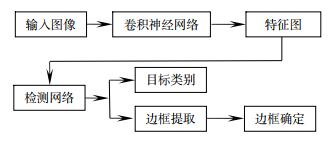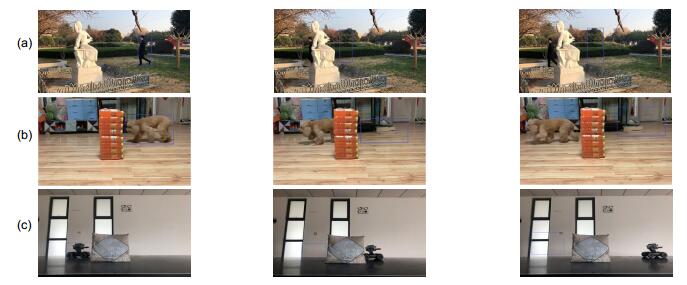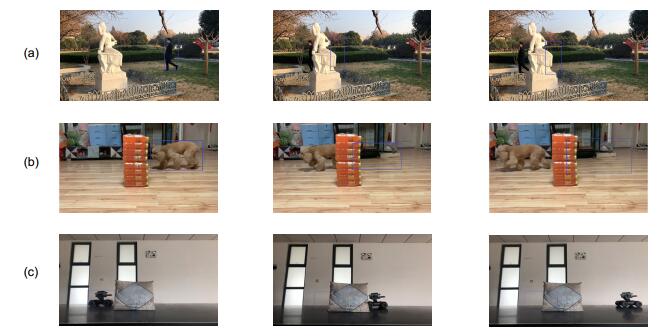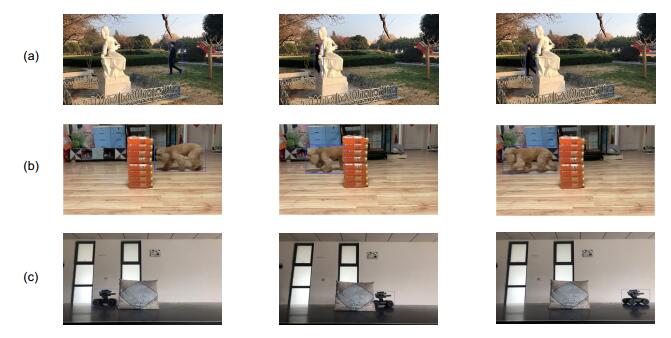-
摘要:
为了解决传统算法在全自动跟踪过程中遇到遮挡或运动速度过快时的目标丢失问题,本文提出一种基于YOLOv3和ASMS的目标跟踪算法。首先通过YOLOv3算法进行目标检测并确定跟踪的初始目标区域,然后基于ASMS算法进行跟踪,实时检测并判断目标跟踪效果,通过二次拟合定位和YOLOv3算法实现跟踪目标丢失后的重新定位。为了进一步提升算法运行效率,本文应用增量剪枝方法,对算法模型进行了压缩。通过与当前主流算法进行对比,实验结果表明,本算法能够很好地解决受到遮挡时跟踪目标的丢失问题,提高了目标检测和跟踪的精度,且具有计算复杂度低、耗时少,实时性高的优点。
 Abstract:
Abstract:In order to solve the problem of loss when the target encounters occlusion or the speed is too fast during the automatic tracking process, a target tracking algorithm based on YOLOv3 and ASMS is proposed. Firstly, the target is detected by the YOLOv3 algorithm and the initial target area to be tracked is determined. After that, the ASMS algorithm is used for tracking. The tracking effect of the target is detected and judged in real time. Repositioning is achieved by quadratic fitting positioning and the YOLOv3 algorithm when the target is lost. Finally, in order to further improve the efficiency of the algorithm, the incremental pruning method is used to compress the algorithm model. Compared with the mainstream algorithms, experimental results show that the proposed algorithm can solve the lost problem when the tracking target is occluded, improving the accuracy of target detection and tracking. It also has advantages of low computational complexity, time-consuming, and high real-time performance.
-
Key words:
- target tracking /
- target loss /
- you look only once v3 /
- model pruning /
- robust scale-adaptive mean-shift
-

Overview: Tracking mobile objects has always been a challenging task and a hot research direction. Now, with the continuous improvement of hardware facilities and the rapid development of artificial intelligence technology, the technology of tracking mobile objects becomes more and more important. In order to solve the problem of loss when the target encounters occlusion or the speed is too fast during the automatic tracking process, this paper combines traditional algorithms with machine learning algorithms. As well as, a target tracking algorithm based on YOLOv3 and ASMS is proposed. Then, by pruning YOLOv3 and combining it with ASMS, the algorithm this paper proposed runs faster. The method of this paper first performs foreground detection through YOLOv3 to find the initial target area for tracking, which eliminats the need to manually circle the region of interest, and then performs tracking based on the ASMS algorithm. The algorithm based on YOLOv3 and ASMS detects and judges the tracking effect of the target in real time. When the tracking frame of ASMS is significantly offset from the detection target or the tracking frame is too large and contains too much background information, the tracking accuracy will decrease. If the target is blocked or moves too fast, it will be lost. For these two cases, YOLOv3 and quadratic fitting positioning are used to relocate to improve the accuracy of the algorithm and solve the problem of target loss. In order to further improve the efficiency of the algorithm, the method of incremental pruning is applied to compress YOLOv3. This article fine-tunes the network to reduce the reduction in algorithm accuracy caused by channel pruning and to prevent excessive pruning from causing network performance degradation. When performing model compression, firstly a scaling factor regular term is introduced for the sparse training of the convolutional layer channel of the YOLOv3 network. Then the global threshold is used to remove the components that are not important to the model reasoning, that is, the less scoring parts. An incremental pruning strategy is further used to prevent network degradation caused by excessive pruning. Finally, this paper fine-tunes the pruning model to compensate for potential temporary performance degradation. Compared with YOLOv3 in COCO database, the experimental results show that the speed of the best pruned algorithm is increased by 49.9%, the model parameters are reduced by 92.0%, and the body weight is reduced by 91.9%. After combining the pruned YOLOv3 with the ASMS algorithm, the experimental results show that the running speed of the proposed joint algorithm is 32.5% faster than the unpruned joint algorithm when the target has occlusion, and the accuracy is much better than that of ASMS. The proposed algorithm can solve the lost problem when the tracking target is occluded, improving the accuracy of target detection and tracking. Moreover, it has advantages of low computational complexity, time-consuming, and high real-time performance.
-

-
表 1 对比模型和剪枝模型评价结果
Table 1. Evaluation results of comparison model and pruning model
模型 精确度 mAP 速度/(f/s) 参数 体量 CPU GPU YOLOv3-tiny 32.7 24.1 48 120 8.9M 33.1MB YOLOv3 55.8 57.9 13 27 60.6M 231MB YOLOv3-50 57.6 56.6 22 48 19.8M 91.7MB YOLOv3-80 51.7 52.4 23 50 12.3M 46.6MB YOLOv3-95 49.4 46.5 27 57 4.8M 18.7MB 表 2 算法对比表
Table 2. Comparison among different algorithms
算法 平均巴氏距离 单帧平均耗时/s 传统ASMS算法 0.786 0.0098 KCF算法 0.795 0.0073 基于YOLOv3和ASMS算法 0.805 0.0631 基于YOLOv3-95和ASMS算法 0.803 0.0463 表 3 算法对比表
Table 3. Comparison among different algorithms
算法 平均巴氏距离 单帧平均耗时/s 行人 动物 小车 行人 动物 小车 ASMS算法 0.3128 0.2564 0.3397 0.0093 0.0101 0.0104 KCF算法 0.3275 0.2631 0.3463 0.0078 0.0073 0.0085 基于YOLOv3和ASMS的算法 0.6965 0.6700 0.7201 0.0626 0.0611 0.0607 基于YOLOv3-95和ASMS的算法 0.6733 0.6574 0.7196 0.0469 0.0460 0.0473 VITAL算法 0.7043 0.6852 0.7253 1.6667 1.6823 1.6295 SANet算法 0.6965 0.6700 0.7201 1.3333 1.3478 1.3256 -
[1] 卢湖川, 李佩霞, 王栋. 目标跟踪算法综述[J]. 模式识别与人工智能, 2018, 31(1): 61-76. https://www.cnki.com.cn/Article/CJFDTOTAL-MSSB201801008.htm
Lu H C, Li P X, Wang D. Visual object tracking: a survey[J]. Pattern Recognit Artif Intell, 2018, 31(1): 61-76. https://www.cnki.com.cn/Article/CJFDTOTAL-MSSB201801008.htm
[2] 李玺, 查宇飞, 张天柱, 等. 深度学习的目标跟踪算法综述[J]. 中国图象图形学报, 2019, 24(12): 2057-2080. doi: 10.11834/jig.190372
Li X, Zha Y F, Zhang T Z, et al. Survey of visual object tracking algorithms based on deep learning[J]. J Image Graph, 2019, 24(12): 2057–2080. doi: 10.11834/jig.190372
[3] 葛宝义, 左宪章, 胡永江. 视觉目标跟踪方法研究综述[J]. 中国图象图形学报, 2018, 23(8): 1091-1107. https://www.cnki.com.cn/Article/CJFDTOTAL-ZGTB201808001.htm
Ge B Y, Zuo X Z, Hu Y J. Review of visual object tracking technology[J]. J Image Graph, 2018, 23(8): 1091–1107. https://www.cnki.com.cn/Article/CJFDTOTAL-ZGTB201808001.htm
[4] Sun D Q, Roth S, Black M J. Secrets of optical flow estimation and their principles[C]//Proceedings of 2010 IEEE Computer Society Conference on Computer Vision and Pattern Recognition, San Francisco, CA, 2010: 2432-2439.
[5] Nummiaro K, Koller-Meier E, Van Gool L. An adaptive color-based particle filter[J]. Image Vis Comput, 2003, 21(1): 99-110. doi: 10.1016/S0262-8856(02)00129-4
[6] Comaniciu D, Ramesh V, Meer P. Real-time tracking of non-rigid objects using mean shift[C]//Proceedings IEEE Conference on Computer Vision and Pattern Recognition. CVPR 2000 (Cat. No. PR00662), Hilton Head Island, SC, 2002: 142–149.
[7] Babenko B, Yang M H, Belongie S. Robust object tracking with online multiple instance learning[J]. IEEE Trans Pattern Anal Mach Intell, 2011, 33(8): 1619–1632. doi: 10.1109/TPAMI.2010.226
[8] Kalal Z, Mikolajczyk K, Matas J. Tracking-learning-detection[J]. IEEE Trans Pattern Anal Mach Intell, 2012, 34(7): 1409–1422. doi: 10.1109/TPAMI.2011.239
[9] Avidan S. Support vector tracking[J]. IEEE Trans Pattern Anal Mach Intell, 2004, 26(8): 1064-1072. doi: 10.1109/TPAMI.2004.53
[10] Vojir T, Noskova J, Matas J. Robust scale-adaptive mean-shift for tracking[C]//Proceedings of the 18th Scandinavian Conference Scandinavian Conference on Image Analysis, Espoo, Finland, 2014: 652–663.
[11] Girshick R, Donahue J, Darrell T, et al. Rich feature hierarchies for accurate object detection and semantic segmentation[C]//Proceedings of 2014 IEEE Conference on Computer Vision and Pattern Recognition, Columbus, OH, 2014: 580–587.
[12] Girshick R. Fast R-CNN[C]//Proceedings of the IEEE International Conference on Computer Vision, Santigago, Chile, 2015: 1440–1448.
[13] Ren S Q, He K M, Girshick R, et al. Faster R-CNN: towards real-time object detection with region proposal networks[J]. IEEE Trans Pattern Anal Mach Intell, 2017, 39(6): 1137–1149. doi: 10.1109/TPAMI.2016.2577031
[14] Redmon J, Divvala S, Girshick R, et al. You only look once: unified, real-time object detection[C]//Proceedings of 2016 IEEE Conference on Computer Vision and Pattern Recognition, Las Vegas, NV, 2016: 779–788.
[15] Liu W, Anguelov D, Erhan D, et al. SSD: single shot MultiBox detector[C]//Proceedings of the 14th European Conference European Conference on Computer Vision, Amsterdam, 2016: 21–37.
[16] Redmon J, Farhadi A. YOLOv3: an incremental improvement[EB/OL]. [2020-02-10]. https://pjreddie.com/media/files/papers/YOLOv3.pdf.
[17] Redmon J, Farhadi A. YOLO9000: better, faster, stronger[C]//Proceedings of 2017 IEEE Conference on Computer Vision and Pattern Recognition, Honolulu, HI, 2017: 6517–6525.
[18] Fu C Y, Liu W, Ranga A, et al. DSSD: deconvolutional single shot detector[EB/OL]. [2020-02-10]. https://arxiv.org/pdf/1701.06659.pdf.
[19] Li Z X, Zhou F Q. FSSD: feature fusion single shot multibox detector[EB/OL]. [2020-02-10]. https://arxiv.org/pdf/1712.00960.pdf.
[20] Liu Z, Li J G, Shen Z Q, et al. Learning efficient convolutional networks through network slimming[C]//Proceedings of 2017 IEEE International Conference on Computer Vision, Venice, Italy, 2017: 2755–2763.
[21] Chen G B, Choi W, Yu X, et al. Learning efficient object detection models with knowledge distillation[EB/OL]. [2020-02-10] http://papers.nips.cc/paper/6676-learning-efficient-object-detection-models-with-knowledge-distillation.pdf.
[22] Wu J X, Leng C, Wang Y H, et al. Quantized convolutional neural networks for mobile devices[C]//Proceedings of 2016 IEEE Conference on Computer Vision and Pattern Recognition, Las Vegas, NV, 2016: 4820–4828.
[23] Huang G, Chen D L, Li T H, et al. Multi-scale dense networks for resource efficient image classification[EB/OL]. [2020-02-10] https://arxiv.org/pdf/1703.09844.pdf.
[24] He M, Zhao H W, Wang G Z, et al. Deep neural network acceleration method based on sparsity[C]//Proceedings of the 15th International Forum International Forum on Digital TV and Wireless Multimedia Communications, Shanghai, China, 2019: 133–145.
[25] Henriques J F, Caseiro R, Martins P, et al. High-speed tracking with kernelized correlation filters[J]. IEEE Trans Pattern Anal Mach Intell, 2015, 37(3): 583–596. doi: 10.1109/TPAMI.2014.2345390
[26] Song Y B, Ma C, Wu X H, et al. VITAL: visual tracking via adversarial learning[C]//Proceedings of 2018 IEEE/CVF Conference on Computer Vision and Pattern Recognition, Salt Lake City, UT, 2018: 8990–8999.
[27] Fan H, Ling H B. SANet: structure-aware network for visual tracking[C]//Proceedings of the 2017 IEEE Conference on Computer Vision and Pattern Recognition Workshops, Honolulu, Hl, 2017: 2217–2224.
-


 E-mail Alert
E-mail Alert RSS
RSS

 下载:
下载:











